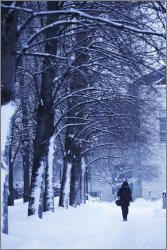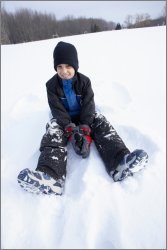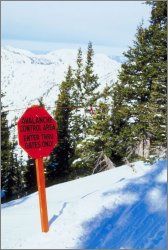|
|

|

15 Things You Never Thought You
Needed to Know About ... Snow
by www.SixWise.com Snow is one of nature's most amazing, and breathtaking, feats.
Few other weather systems are capable of causing such fury
-- grounded planes, traffic jams, closed schools -- and such
beauty -- snow-covered ski slopes, fields blanketed in fresh
white powder and, of course, snowflakes falling on Christmas
morning -- as snow.
|

Snowstorms hit the United States an average of 105
times a year.
|
Snow is also very interesting, more interesting than you
may have thought, and the following facts are a perfect conversation
piece to keep close with you during this winter season.
-
There are an average of 105 snow-producing storms in
the continental United States each year.
-
Skiers have their own "snow language," which
was created back in the 1900s to describe different snow
conditions. Some of the earlier terms included "fluffy
snow," "powder snow" and "sticky snow."
Later terms include "champagne powder," "corduroy,"
and "mashed potatoes."
-
Hundreds of people die from snow-related causes in the
United States each year. Top causes include traffic accidents,
overexertion, exposure and avalanches.
-
The snowiest large city in the United States is Rochester,
New York, with an average 94 inches of snow each year.
-
About 70 percent of the annual snowfall in the United
States falls during December, January and February. (Near
the eastern Rocky Mountains, however, the snowiest months
are often March and April.)
|

Snow can either muffle or amplify sounds, depending
on its surface.
|
-
The saying that "10 inches of snow contains one
inch of water" is mostly a myth. Ten inches of snow
can actually contain anywhere from 0.10 inches to four
inches of water.
-
Snow appears white because snow crystals absorb visible
sunlight (which is white) and reflect it from countless
tiny surfaces.
-
Most snowflakes
are less than one-half inch across, but they can reach
up to two inches across.
-
It's never too cold to snow, but most heavy snowfalls
occur when it's 15°F or warmer (the air can hold more
water vapor when it's warmer).
-
1Snow is an incredibly good insulator. Why? Fresh snow
typically contains 90 percent to 95 percent trapped air
that can barely move around, meaning heat transfer is
greatly reduced.
-
Icicles are more likely to form on the south side of
buildings. This happens because snow that is facing south
is able to melt during the day, then freeze again at night.
(North-facing snow often does not melt because it doesn't
get as much sunlight during the day).
|

Avalanches are most likely to run from December to
April.
|
-
It's possible, though rare, to have thunder and lightening
during a snowstorm (and it's more likely to occur near
the coast).
-
A "Nor'easter" is a cyclonic storm that occurs
off the east coast of North America. They're known for
producing heavy snow, rain and huge waves.
-
A thick layer of fresh, fluffy snow will absorb sound
waves, making sounds less audible. However, as snow ages
the surface can become smooth and hard. In this state,
the surface will reflect sound waves, making sounds clearer
and able to travel farther distances.
-
Avalanches are most likely to "run" (slide
down a slope) from December to April, but avalanche fatalities
have occurred during every month of the year.
Recommended Reading
Are
No Two Snowflakes Really Alike? (and Other Amazing Snowflake
Facts & Pictures)
Can
Joints and Knees that Ache Really Predict a Change in the
Weather?
Sources
National Snow
and Ice Data Center (NSIDC)
The
Snow Booklet
To get more information about this and other highly important topics, sign up for your free subscription to our weekly SixWise.com "Be Safe, Live Long & Prosper" e-newsletter.
With every issue of the free SixWise.com newsletter, you’ll get access to the insights, products, services, and more that can truly improve your well-being, peace of mind, and therefore your life!
|
|
|
|